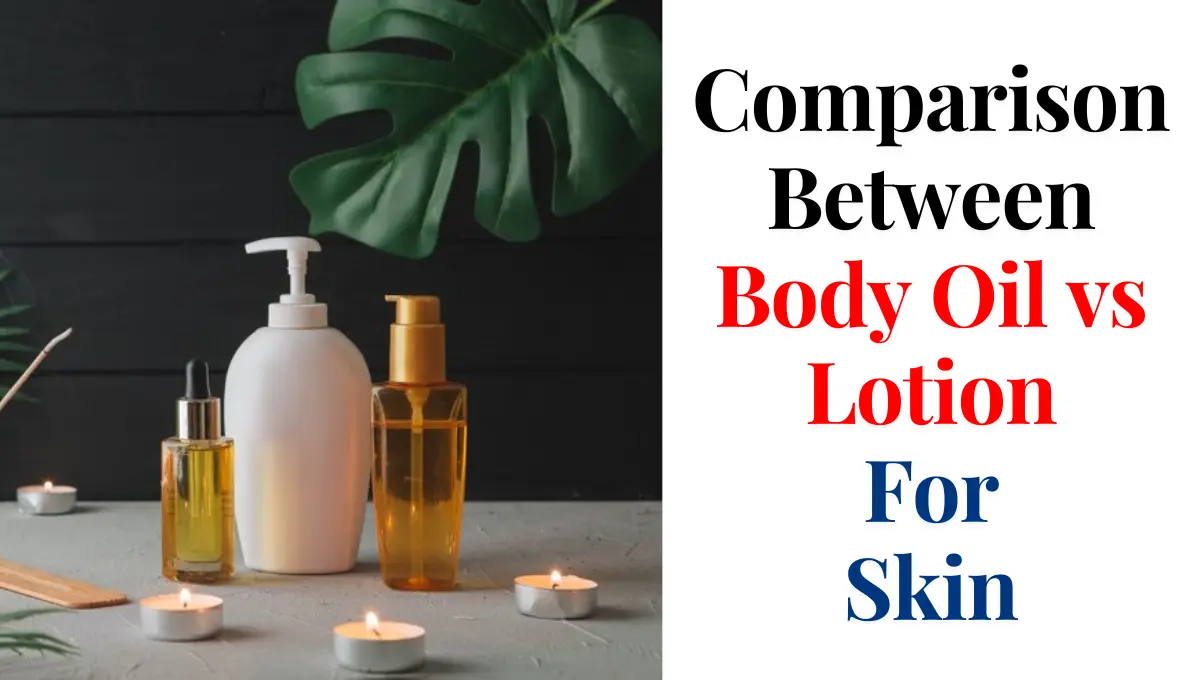The age-old argument between body oil vs lotion has ignited a Glow Battle among skincare lovers in their quest for nourished, glowing skin. People are left wondering which elixir would work better for their skin because each has unique benefits.
The search for the ideal hydration partner has sparked an intriguing investigation into texture, rate of absorption, and general efficacy. Come along as we explore the worlds of body oil and lotion, breaking down each product’s benefits so you may choose wisely for that desired radiant glow.
It’s time to explore the skincare landscape and understand the differences between these two competitors in the fight for incredibly moisturized skin.
What Is Body Oil?
Body oil is a cosmetic product that is applied to the skin to moisturize, nourish, and enhance its appearance. Unlike lotions and creams, which are water-based, body oils are typically made from a combination of oils such as coconut, jojoba, almond, or grapeseed oil.
These oils are rich in fatty acids and other nutrients that help to hydrate the skin and maintain its natural moisture barrier. Body oils can be used to address dry skin, especially in areas prone to roughness such as elbows, knees, and heels.
They are known for providing a luxurious and indulgent feel upon application, leaving the skin with a soft and smooth texture. Additionally, somebody oils may contain added fragrances or essential oils, contributing to a pleasant scent and potential aromatherapy benefits.
People often use body oil after showering or bathing by applying it directly to damp skin. This helps to lock in moisture and maximize the absorption of the oils. Body oils can be a part of a regular skincare routine, promoting overall skin health and radiance.
What Is Body Lotion?
The body lotion is a skincare product designed to moisturize and nourish the skin. It is a type of emollient that typically contains a combination of water, oils, and other ingredients such as humectants and preservatives.
The primary purpose of body lotion is to hydrate the skin, leaving it feeling soft, smooth, and supple. The water content in body lotions helps to provide immediate hydration, while the oils create a protective barrier on the skin’s surface to prevent moisture loss.
Humectants, like glycerin or hyaluronic acid, attract and retain water, further enhancing the moisturizing effects. Body lotions are commonly used after bathing or showering when the skin is clean and pores are open.
Applying lotion to damp skin can help seal in moisture and maximize the product’s effectiveness. Regular use of body lotion can be beneficial for maintaining skin health, preventing dryness, and addressing issues like flakiness or rough patches.
Body Oil And Lotion Have Their Pros And Cons
Both body oil and lotion have their pros and cons, so choosing the right one depends on your skin type and desired outcome. Let’s break it down:
Body Oil:
- Pros:
- Creates a barrier on the skin, sealing in moisture and preventing evaporation.
- Great for dry to extremely dry skin, providing intense hydration.
- Offers additional nutrients and antioxidants depending on the oil used (e.g., jojoba, argan).
- Leaves a dewy, radiant finish.
- Cons:
- Can feel greasy or heavy, especially on non-dry skin.
- Slower absorption time, making it less convenient for quick application.
- May clog pores if not chosen carefully (non-comedogenic oils are key).
Body Lotion:
- Pros:
- Lightweight and fast-absorbing, suitable for normal to dry skin.
- Offers various formulas and ingredients to target specific concerns (e.g., sensitive skin, anti-aging).
- More readily available and often budget-friendly.
- Less greasy feeling compared to oil.
- Cons:
- May not provide enough hydration for extremely dry skin.
- The barrier function is not as strong as oil, so moisture loss can occur faster.
- Lightweight nature means more frequent application may be needed.
Benefits of Adding a Body Oil and Lotion
Adding both body oil and lotion to your skincare routine can offer various benefits, as they complement each other in providing comprehensive skin care. Here are the benefits of incorporating both into your routine:
1. Deep Hydration: Body oil and lotion work together to provide deep hydration to the skin. While body oil seals in moisture and prevents water loss, lotion adds a layer of hydration, making the skin feel soft and supple.
2. Enhanced Moisture Retention: The combination of body oil and lotion helps to retain moisture in the skin, preventing dryness and flakiness. This is especially beneficial in areas prone to roughness, such as elbows, knees, and heels.
3. Improved Skin Texture: Regular use of body oil and lotion contributes to smoother and healthier-looking skin. The emollient properties of these products help to soften rough patches and promote an overall improved skin texture.
4. Luxurious Feel: Body oil provides a luxurious and indulgent feel upon application, contributing to a spa-like experience. The lightweight texture of oils and the silky finish of lotions can make the skincare routine a pleasant and soothing ritual.
5. Aromatherapy Benefits: Many body oils and lotions come with added fragrances or essential oils, providing aromatherapy benefits. The scents can have a relaxing or uplifting effect, enhancing the overall sensory experience of your skincare routine.
6. Customization for Specific Needs: Body lotions often come with specialized formulations to address specific skin concerns, such as anti-aging, soothing irritated skin, or improving firmness. Combining a targeted lotion with a nourishing body oil allows you to tailor your skincare routine to your individual needs.
7. Post-Bath or Shower Application: Applying body oil to damp skin after bathing helps lock in moisture while following up with lotion enhances the moisturizing effect. This post-bath application routine ensures optimal absorption and effectiveness of both products.
8. Overall Skin Health: The dual use of body oil and lotion contributes to overall skin health by providing a balanced approach to hydration and nourishment. It helps maintain the skin’s natural moisture balance, promoting a radiant and healthy complexion.
Tips and Tricks:
Instant insights to enhance various aspects of life, from skincare and productivity to time management and beyond. Small-sized knowledge for you to be better, and more efficient.
Tips and Tricks for Body Oil:
- Choose the right oil: Different oils have different properties. For dry skin, try jojoba, argan, or avocado oil. For sensitive skin, opt for almond, rosehip, or grapeseed oil. Avoid comedogenic oils like coconut oil if you’re prone to breakouts.
- Warm it up: Slightly warm the oil by rubbing it between your palms before applying. This helps with absorption and feels luxurious.
- Apply on damp skin: After showering or bathing, pat your skin dry with a towel, leaving it slightly damp. This helps trap moisture and the oil will absorb better.
- Target specific areas: Focus on dry, rough patches like elbows, knees, and heels.
- Mix it up: Add a few drops of your favorite essential oil to the body oil for a relaxing or invigorating scent.
- Layer with lotion: For intense hydration, apply a lightweight lotion followed by a thin layer of body oil to lock it in.
- Pat, don’t rub: Gently pat the oil onto your skin instead of rubbing, which can be harsh and cause irritation.
- Go for the glow: If you prefer a subtle glow, mix a few drops of body oil with your body lotion.
- Store it right: Keep your body oil in a cool, dark place to prevent it from going rancid.
Tips and Tricks for Body Lotion:
- Exfoliate regularly: This removes dead skin cells, allowing the lotion to penetrate deeper and be more effective.
- Moisturize daily: Aim to moisturize your body twice a day, especially after showering or bathing.
- Pay attention to your skin type: Choose a lotion formulated for your specific skin type. For dry skin, look for thicker, creamier formulas with ingredients like hyaluronic acid or shea butter. For oily skin, opt for lightweight, oil-free lotions.
- Look for added benefits: Many lotions offer additional benefits like sun protection, anti-aging properties, or scent. Choose one that addresses your specific needs.
- Don’t forget your hands and feet: These areas often get neglected but need moisture too. Apply lotion to your hands and feet regularly.
- Reapply throughout the day: Especially if you have dry skin, you may need to reapply lotion throughout the day, especially after washing your hands or spending time outdoors.
- Consider a body butter: For extra dry skin, body butter provides even more intense hydration.
- DIY it: If you’re crafty, you can even make your body lotion with natural ingredients like coconut oil, shea butter, and essential oils.
Where to Shop:
When it comes to shopping, you have numerous options depending on your preferences and needs. Here are some common places where people shop:
- Physical Retail Stores: Visit local malls, department stores, or specialty shops for a hands-on shopping experience.
- Online Retailers: Explore a wide range of products on online platforms such as Amazon, eBay, or specific brand websites.
- Grocery Stores: Find fresh produce, pantry staples, and household items at your nearest grocery store or supermarket.
- Local Markets: Support local vendors and discover unique products by shopping at farmers’ markets or artisanal markets.
- Thrift and Secondhand Shops: Browse thrift stores or online platforms like thrift apps and websites for budget-friendly and sustainable shopping.
- Specialty Boutiques: Check out specialty stores that focus on specific categories, offering a curated selection of products.
- Discount Stores: Explore discount retailers for budget-friendly options, often carrying a variety of products at lower prices.
- Convenience Stores: Grab everyday essentials at convenience stores, which are convenient for quick, small purchases.
- Department Stores: Find a variety of products under one roof at department stores, catering to different needs and preferences.
- Subscription Services: Subscribe to curated boxes or services that deliver products regularly based on your preferences, such as beauty products, snacks, or books.
- Local Shops and Businesses: Support local businesses by shopping at locally-owned stores, contributing to the community.

